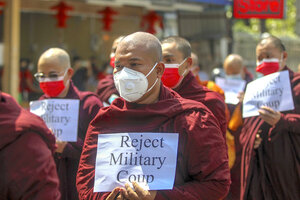The saffron color of power in Myanmar
The military’s Feb. 1 coup has focused not only on pro-democracy civilian leaders but Buddhist monks, whose moral and spiritual legitimacy holds sway over who rules in Myanmar.

Buddhist monks march during a protest against the military coup in Yangon, Myanmar, Feb. 16.
AP
More than two weeks after a military coup in Myanmar, over 100,000 protesters were again on the streets Wednesday demanding a return to democracy. For days, the variety of the crowds has been as impressive as their size. Demonstrators include comedians, cyclists, civil servants, teachers, railway workers, farmers, members of the old royal court, and even women dressed as Disney princesses (to inspire young girls to participate). Yet in the eyes of the coup leader, army Gen. Min Aung Hlaing, the most worrisome protesters may be saffron-robed Buddhist monks.
In largely Buddhist Myanmar, formerly known as Burma, monks were in the front lines of protests in 1988 and 2007 that finally led to the military granting a partial democracy in 2011. In ancient days, the monastic order, or sangha, merely had to hint that a king was illegitimate and he was gone. The power of monks to shape public opinion comes from their daily ritual of receiving alms from believers, walking barefoot door to door with shaved heads carrying begging bowls.
They are seen as selfless, above worldly ways, and dedicated to relieving human suffering. This allows them to call for compassionate rulers who are peaceful and meet the needs of all the people. It also may account for the peaceful nature of the protests.
Their moral and spiritual authority could once more bring the military to heel. The army is taking no chances. Since the Feb. 1 coup, a number of leading monks, such as well-known U Thawbita in Mandalay, have been arrested and sentenced. (These pro-democracy monks are opposed to some in their religious community who call for suppressing non-Buddhists in Myanmar, such as the Muslim Rohingya.) They may be less popular than Aung San Suu Kyi, leader of the National League for Democracy, but during the protests, multicolored Buddhist flags are waving beside the red banners of her political party.
Both the military and Ms. Aung San Suu Kyi have competed to persuade the monks of their righteousness. She is now under arrest. Most of the monks are not. Their people-centered humility in service to democracy may again sway the future despite the army’s threats of violence against the protesters. Power in Myanmar doesn’t always come out of the barrel of a gun.

